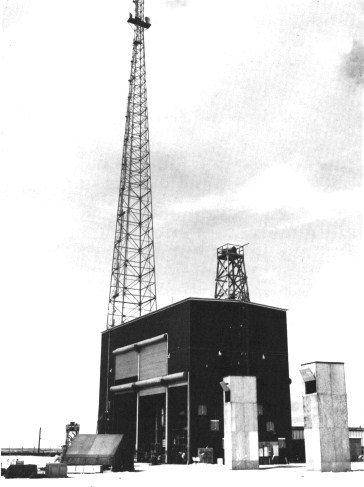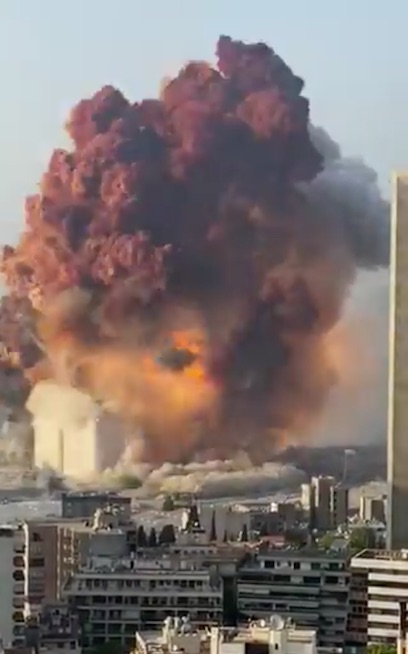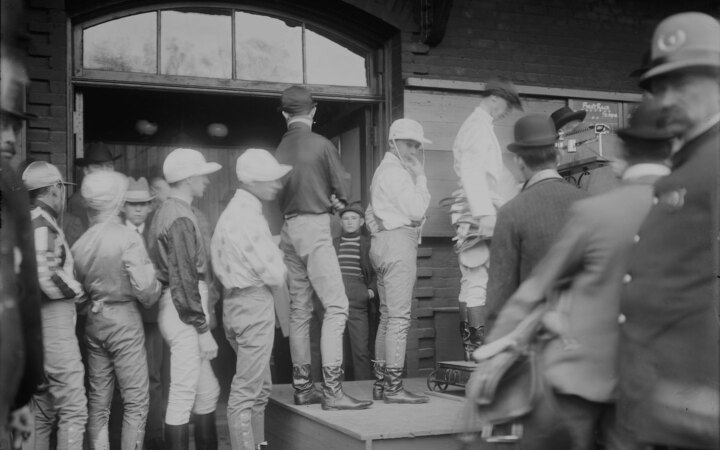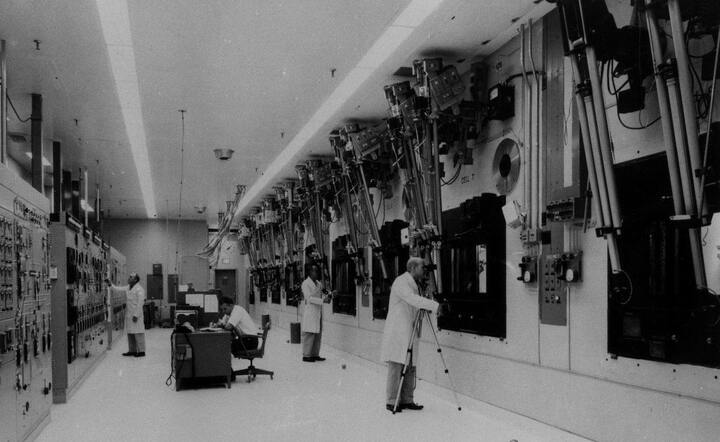The Little Boy bomb detonated over Hiroshima in 1945 was a fission weapon where a critical mass of uranium-235 created a chain reaction of atoms splitting into lighter atoms, releasing energy and neutrons. While such weapons are very destructive, they are “inefficient” in that as the bomb starts to explode, it pushes the uranium-235 atoms away from each other. This quickly eliminates the critical mass, meaning most of the atoms never undergo fission at all.
Thermonuclear weapons use another principle: If deuterium and tritium (isotopes of hydrogen with extra neutrons) are put together at very high temperatures, they will fuse into helium, generating energy in the process. Roughly speaking, fusion bombs wrap a layer of deuterium and tritium around a fission bomb. The outer fusion reaction creates a huge number of neutrons that make the inner fission reaction much more complete.
The first demonstration of this principle was Ivy Mike in 1952, an explosion 500 times more powerful than Little Boy. Other detonations quickly followed. In 1961, Tsar Bomba was the largest man-made explosion in history, 2,500 times more powerful than Little Boy.
Yet today, almost all deployed nuclear warheads are smaller, and there’s little interest in making them bigger. The largest American bomb (the B83) is eight times less powerful than Ivy Mike. The warheads on ballistic missiles (e.g. the W76, W78, or W80) are only 5-20x more powerful than Little Boy. The Russian arsenal is similar.
Why is that?
1. These big bombs were really big.
Ivy Mike looked less like a “bomb” and more like a “factory”.

Tsar Bomba was a normal-looking bomb. But it was large (8 meters long and 2.1 meters wide) and very heavy (26 tonnes). For comparison, a modern 737 freighter has a total payload of around 18 tonnes. The bomb required a 1.6 km2 parachute, and a specially modified plane to carry and drop it. Even with a special paint to reflect heat, it was estimated that the flight crew only had a 50% chance of survival. (They did survive—the shock wave caught the plane and it dropped 1 km in the sky but then recovered.)
That is to say, it would be difficult to use these things in war. It’s likely possible to create smaller versions, but there’s little interest in doing that, for the reasons below.
2. Existing bombs are already very destructive.
Current thermonuclear bombs are stupidly powerful. Typically they are measured in tonnes of TNT equivalent. That’s OK, but I don’t think it’s very intuitive—the mind simply can’t grasp the magnitudes.
Here’s the Ever Fortune, a recently launched Evergreen F-class container ship:

A little math:
- This ship can carry 12,000 shipping containers.
- A shipping container has a volume of around 33.3 m3.
- TNT has a density of 1.654 tonnes/m3.
So this ship could carry:
12000 × 33.3 × 1.654 ≈ 660 thousand tonnes of TNT.
Or, you probably remember the accidental explosion of ammonium nitrate in the Port of Beirut in 2020.

The best estimates are that this was equivalent to around 500 tonnes of TNT.
Using these, we can measure the yield of weapons in terms of the “number of Ever Fortunes”, and the “number of Beiruits”.
| bomb | tonnes of TNT | Ever Fortunes | Beiruts |
|---|---|---|---|
| W76 | 100 thousand | 0.15 | 200 |
| W78 | 350 thousand | 0.53 | 700 |
| W80 | 150 thousand | 0.23 | 300 |
| B83 | 1.2 million | 1.8 | 2,400 |
| Ivy Mike | 10 million | 15 | 20,000 |
| Tsar Bomba | 50 million | 75 | 100,000 |
The B83 is already more powerful than an entire container ship full of TNT, or two thousand of the explosions in Beirut. If you detonate that near any single object, that object is gone. Humans don’t build things that can withstand such a blast.
3. The surface of the earth is a two-dimensional manifold.
Physical space is three-dimensional, but human civilization is concentrated on the two-dimensional surface of the earth. The larger a bomb is, the larger the fraction of energy that is “wasted” by shooting up into the sky or into the ground rather than going horizontally to where all the people and buildings are.
Because of this, the effective destruction is often modeled as
DESTRUCTION = YIELD2/3.
While Tsar Bomba was around 42 times more powerful than a B83, the area of effective destruction is only around 12 times larger.
So, part of the answer to why nukes aren’t getting bigger is—what’s the point? If you want to destroy a single object, a modestly sized nuke will do the job. If you want to destroy an entire area it is more efficient to take the same amount of nuclear material and split it up into multiple warheads.
Speaking of multiple warheads…
4. MRVs and MIRVs exist.
The idea of a multiple reentry vehicle (MRV) is to release multiple warheads that spread out and detonate in a cluster around a given target. The first MRV was the Polaris A-3 in 1964.
MRVs aren’t quite the same as multiple independently targetable reentry vehicles (MIRVs). The key difference is that MIRVs can target multiple precise locations, which may be hundreds of kilometers apart. A MIRV first adjusts itself to a ballistic trajectory and releases a warhead so it will passively fall on the first target, then repeats the process for each of the warheads. The first MIRV was the Minuteman III in 1970.
Now, let’s compare a single large warhead to the same yield split among several warheads in a MIRV. The MIRV:
- Can destroy a larger area.
- Can destroy multiple targets.
- Is harder to intercept with missile defense.
Currently, the US, the UK, Russia, France, China, and (probably) Israel have MIRVs. They’re under development by India, Iran, and Pakistan.
Incidentally, the largest currently-deployed warhead is on the Chinese DF-5 with a yield of 5 million tonnes— more than four times larger than the most powerful American warhead. However, China has reportedly begun replacing the DF-5 with a MIRV system of (presumably) smaller warheads.
4. Delivery systems are getting more accurate.
There are three main ways to deliver nuclear warheads: Drop bombs from planes, fire ballistic missiles from land, and fire ballistic missiles from submarines. This is the “nuclear triad”. (Nuclear cruise missiles, artillery shells, land mines, depth charges, and torpedos also exist.)
The accuracy of these systems is involved, but things are trending towards higher accuracy. (Feel free to skip to the bottom of this section if you don’t want to be bothered with the details.)
Bombs from planes
In World War II, the only option was to drop unguided bombs out of planes, which had a typical accuracy. The typical accuracy was around 400 meters (Correll, 2010), though this depends heavily on altitude, weather, if the plane is being shot at, etc. Unguided bombs seem to have become more accurate since then, but hard numbers are scarce.
“Smart bombs” started to be developed in the 1960s. These have fins that they adjust while falling to steer towards a target. The first smart bomb had a television camera that the pilot would “lock on” to a target before dropping. This was followed by more accurate laser-guided bombs that are dropped from one plane and seek out a laser with an encrypted pulse sequence that was pointed by a second plane. These could be as accurate as 5 meters, but the need to continuously aim a laser is a major downside.
Since 19997, the US has replaced nearly all unguided bombs with Joint Direct Attack Munitions or JDAMs. These combine inertial guidance with GPS signals. They have a reported accuracy of 30 meters when just using inertial guidance, and 5 meters when combined with GPS. (Which might not be available in a nuclear war). Oddly, American nuclear warheads are not JDAM compatible, which at the moment leaves American nuclear bombs as exceptional in remaining unguided and less accurate. However, there is a program underway to upgrade the bombs with a JDAM-like system.
A weird edge case is the Russian SVP-24. This isn’t a bomb, but rather a targeting computer for planes to drop unguided bombs more accurately. Some Russian sources claim this is as accurate as a smart bomb. These sources aren’t very credible but it seems to have performed well during the Russian intervention in Syria because Russia is adding the SVP-24 to all their bombers as quickly as possible.
Land-based intercontinental ballistic missiles (ICMBs)
The first ICMB, the Minuteman I, started in 1961 with an accuracy of 2.4 km. This was improved (somehow) within a few years to 1.1 km. That improved to 480 meters in 1964 with the Minuteman II and to around 220 meters in 1968 with the Minuteman III. It’s rumored that an update to the inertial guidance system has since improved that to around 120 meters.
In 1986, the US introduced the Peacekeeper with an accuracy of 40 meters. Oddly, these missiles were retired in 2005 and converted for use as an orbital launch system, leaving the Minuteman III as the only American ICBM. (This was done to comply with the START-II treaty which came into effect in 2000—even though Russia withdrew from that treaty in 2002.) The US is working on a new Ground Based Strategic Deterrent, supposedly to be deployed in 2029.
China is developing the Dongfeng series of missiles. The DF-4, introduced in the late 1970s, has an accuracy of around 1.5 km, while the DF-41, introduced in 2017, has an accuracy of around 100 meters.
Submarine-launched ballistic missiles (SLBMs)
The Polaris was the first SLBM. It entered service in 1961 with an accuracy of 900 meters. This was followed by the Poseidon in 1971 with an accuracy of 550 meters and the Trident I in 1979 with an accuracy of 200-500 meters. In 1990, the Trident II entered with an accuracy of 381 meters, later decreased to120, or 90 with GPS.
It’s hard to be confident about the above accuracy numbers, especially for non-NATO countries where less information is available. But it’s clear that accuracy has greatly increased over time, and this trend is likely to continue.
Why does this matter? Well, if you can’t hit a target, you try to make up for that by having an extra-large explosion. Thus, more accurate delivery systems mean less desire for larger bombs.
5. Earth penetrating weapons are improving.
Why do nations want to have nuclear weapons?
One purpose is coercion—if I have nukes and you don’t, I can force you to do what I want or I’ll destroy your cities. Deterrence is similar—you better not destroy all my cities because if you do, I’ll destroy all your cities in return.
While these are important, nukes have another central purpose: To destroy other countries’ nukes (and command centers, airports, factories, etc.) so that they can’t be used to destroy your cities.
From early in the cold war, there was an intense fear from both the US and USSR that the other side might launch a first strike that would eliminate their ability to respond. This set in motion an arms race of silos, bombs that could blow up silos, mobile nuclear launchers, submarines, spy satellites, etc. From 1960 to 1968, the US kept nuclear-armed B-52 bombers in the air near the USSR at all times.
For a time, if you wanted to destroy an enemy’s missile silo, it seemed like you needed a very large warhead. That’s because targeting was inaccurate, but a powerful weapon might still do the job with a near miss.
These days, there’s much less interest in using gigantic warheads to destroy missile silos. That’s because:
- Submarine-launched missiles now exist. A submarine is easy to destroy with a small weapon, provided you can find and hit it. Larger nukes are irrelevant to this arms race.
- There’s an increased focus on accuracy. To destroy a given target, rather than making a bomb twice as powerful, it’s easier to make it twice as accurate. (In fact, making a bomb twice as accurate will more than double the damage, due to the way energy spreads out in space.)
- Earth penetrating weapons now exist. Since missile silos are hardened with concrete, etc., weapons have been designed to penetrate into the silo before detonating. These do things like encase the warhead in tungsten which has a very high melting point and so can “liquify” and penetrate 30-45 meters into concrete. Even a small penetration vastly increases the damage, since it means the energy is directed into the ground rather than into the air.
As things stand, it’s unclear if militaries would be able to disable each other’s nukes in a conflict. Some people suggest that even a near miss would cover a silo in rubble and prevent a launch. But there are also reports that some countries are just digging silos even deeper and even stashing boring machines in the silos so they can dig out.
Whatever the truth is, in the arms race where other countries seek the ability to disable other’s nuclear capabilities, make the nukes bigger isn’t a very important factor these days. It’s about more accurate targeting, more silent submarines, airplane cloaking, spy satellites to detect where the nukes actually are, and so on.
Smaller warheads in bunker-buster nukes is a positive thing in one sense: Ground-burst nukes generate vastly more nuclear fallout than air-burst nukes. So switching to lower yields with higher accuracy probably means less damage to anyone who happens to live downwind.
Summary
Nukes aren’t really getting bigger anymore. But—as someone concerned about nuclear war—it’s hard to see this as an optimistic trend. It’s happened because:
- Bigger nukes are less relevant to the quest to disable other nations’ nukes.
- We now have even more effective ways to destroy stuff and kill people, namely making multiple smaller warheads and precisely targeting them to maximize the effect.
(Thanks to Austin Vernon for a helpful discussion.)







































